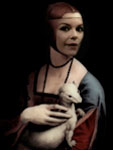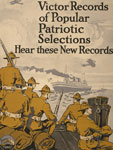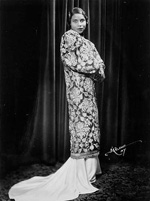Celebration of Negro Spirituals, Part Five
A series of speakers, primarily professors, open a symposium celebrating the history and impact of African-American spirituals.
A series of speakers, primarily professors, open a symposium celebrating the history and impact of African-American spirituals.
A series of speakers, primarily professors, open a symposium celebrating the history and impact of African-American spirituals. This presentation continues from the presentation "Celebration of Negro Spirituals, Part One."
A series of speakers, primarily professors, open a symposium celebrating the history and impact of African-American spirituals.



Growing up in the '70’s, I can recall Schoolhouse Rock being a wonderful respite from the otherwise frenetic and vacuous menagerie of Saturday morning cartoons. It still had funk (who can forget the red-bell-bottoms-with-star-top ensemble and get-down voice featured in “Sufferin’ ‘Till Suffrage”), but it called to my inner Barbara Tuchman.
A decade later all that flew out the window as my generation became known as the “MTV generation,” unified by the power of fast-paced, self-indulgent, visually-stimulating music videos. Bopping around in my room in a neon mini to Culture Club, I had no idea then that someday I’d marry the two concepts together for use in my teaching career.
I’ve always liked to sing, and make no apologies for my insistence on “retro” ‘80’s new wave in the car CD changer or on karaoke nights. Having a rather dark sense of humor, I’ve also always been drawn to parody, whether it be a Weird Al hit or Mel Brooks blockbuster. Enter Clio, the muse of history. One long drive home on the freeway, I was blasting ABBA’s “Money, Money, Money” and could not get the day’s European History lesson plans out of my head. That’s right, suddenly “money” morphed into “Henry” and by the time I’d reached my destination I’d worked out lyrics relating to four of Henry VIII’s six wives. A few days later I penned a song about significant “Renaissance Men” to a Violent Femmes classic. I’d used rhymes and even short ditties as educational mnemonic devices before, and saw no reason why my 9th-grade students wouldn’t enjoy having a listen to these—at least, I thought, they’d remember the order of the Tudor women and that only two were actually beheaded.

Enter Tyche, goddess of luck. It just so happened that at the time I was working with a true Renaissance man, Herb Mahelona, who not only was an accomplished musician and composer (he had written more than one opera), but also a former history and art teacher with some mad tech skills! He suggested that, in lieu of me standing awkwardly in front of the class singing, we make a music video that would incorporate a decent recording and some eye-catching visuals using Adobe Flash animation. After our third song, he suggested I appear in the actual video as well. The videos, although time-consuming, were an instant hit and students began sharing them with friends from other schools and—gasp!—parents!

The students' enthusiasm had an effect on us, and we created more videos. Subject matter came naturally—we tried to stick to classically significant people and events. Movements or eras were a bit trickier, which was why I could never quite get to writing that feudalism song.
I say “we” because at this point, both Herb and I were penning lyrics, each driven by our own passions and tastes and each expressing our unique style. Although our processes are slightly different, we both begin a song by plotting out the key concepts and vocabulary we feel students will need to understand and remember. I usually take that list and see if anything even slightly rhymes (you can cheat a bit when singing), such as “acral necrosis/yersinia pestis” in “Black Death” or “quill pen/vermillion” in “Illuminated Manuscripts.” Of course, prior to that one has to make the perfect match of original tune to parody and topic. The music should make sense with the feel of the story, but to make parody memorable, it’s imperative that a “hook” can be established—that the new lyric replaces a crucial element in the original (such as “Oh, Constantine”/”Come on Eileen”). To be honest, this match sort of “hits” me—usually whilst driving and singing along to a favorite chart-topper. We both have a running list of ideas to start when we get that most precious element—time.
Despite the fact that our own students were raving about the videos and finding them useful as study aids and provocations to learn more, we knew we needed to do something grander with this labor of love. My first idea was to have students synthesize their own research into lyrics (not an easy task!) and learn more about technology and project management by recording their songs and creating music videos using iMovie. I was blown away, and they get better every year. Finally, after much prodding from students, we decided to post the videos on YouTube to see what sort of response we’d receive. The site had only been around a few years, and I didn’t realize then how useful it could be in the classroom. To this day I strongly disagree with any attempt to block (especially educators) from accessing YouTube at school.
We were surprised by:
This past year we’ve been asked to consult with museums, speak at conferences (including TEDx Honolulu), and do live interviews. We’ve even had friends in another state tell us they’ve heard students singing one of our songs in a coffee place. The greatest joy is communicating with “fans” of all ages through social media, where we’ve discovered some innovative kids taking up the torch and producing history videos of their own. That’s the beauty of 21st-century technology—everyone’s passion, expressed through their creative ideas, can come to fruition with the ease of the tools at hand. Teachers and students can shift from content consumers to content creators, and truly break out of the classroom box to share with an authentic, global audience. Creativity is contagious, and only brings our world closer together as we share in what makes us human—art, music, storytelling, and collective memory.
To see more of Amy Burvall's videos, check out her YouTube channel. Remember that Burvall's techniques and ideas aren't limited to world history—U.S. history students can also benefit from synthesizing and presenting their content knowledge in creative, coherent ways.
Teachinghistory.org blog author and assistant professor of social studies/history education Anthony Pellegrino has used music in his classrooms, too. Read his general principles for teaching with music as a primary source or examples of how he uses it when teaching about labor movements.
If you're interested in creating music videos yourself (or in asking your students to create them), you'll need to know the tools to use. Tech for Teachers looks at digital storytelling tools like Animoto, hardware like document cameras, and video-hosting services like Vimeo and YouTube. Think about what you want to do and find and familiarize yourself with the tools you'll need, before you jump off into the deep end!

You don't have to look far to see how important music is to modern American life. Young people (as well as adults) talk about music, listen to music, download music, remix music, share music, and define themselves by music. In classrooms across the country, MP3 players and pop-tune ringtones give students' musical tastes away (and get them in trouble). But has music always been this personal, portable, and repeatable?
Ask your students to think back. Do they remember a time when music wasn't something you could own? When they, someone in their family, or someone they knew didn't have an MP3 player—or a CD, tape, or record player?
Before the birth of the recording industry, you could buy sheet music and learn how to perform musical pieces for yourself—but that was it. An individual performance was ephemeral, literally once in a lifetime.
When the recording industry took off, music became an object. Now you could buy and trade moments in musical time, preserved forever. You could listen to artists who lived far away from you, whom you might never see live. You could listen to your favorite performances again and again. You could even sell music, without having to worry about arranging performances. One song sung once by one artist could earn money for months or years to come. Sound become solid, something that could be passed from hand to hand—and preserved.
On May 10, 2011, the Library of Congress launched its National Jukebox, an online archive of more than 10,000 recordings from 1901–1925. According to the website, Library of Congress staff worked throughout 2010 to digitize this massive collection of Victor Talking Machine Company recordings (Victor, now RCA, is one of the oldest record companies in existence, according to the Library of Congress's blog entry announcing the launch of the Jukebox).
You can browse the recordings by vocal artist, composer, lyricist, language, place or date of recording, target audience, label, category, or genre. And if you find some music you'd like to remember? Add it to your playlist in the site's pop-up player. Now you can listen to it while you browse other sites, email it to yourself to listen to later, or share it with others on social media sites or by embedding it in a blog or website.
While exploring the Jukebox is entertaining in its own right—I just spent two minutes listening to humorous singer Burt Shepard trying to lure a lost cat home—it also makes invaluable primary sources easily accessible.
Teaching about the rise of ragtime and jazz? Make a playlist of famous (and less famous) songs and artists and share it with your students.
How about the invention of the airplane? The Haydn Quartet's "Up in My Aeroplane" can give students an idea of the romance and novelty of flight six years after the Wright Brothers' first successful test run.
World War I? "Hooray, the war is over!" sings Harry Lauder in 1918; months earlier, baritone Reinald Werrenrath remembered the U.S.'s debt to Lafayette and to embattled France.
Pick a time period, a genre, an artist, a word—and go looking! There's something in this storehouse to accompany almost any topic from 1901–1925, if you look hard enough. Use the recordings to grab your students' attention—or ask them to analyze or compare music and lyrics. What do the words (if you choose a vocal piece) say? What emotions does the piece seem to seek to evoke? When was it recorded? Where? Who audience did the composer, artist, or publisher have in mind?
Finding music by topic can be difficult, as none of the pieces have transcriptions, but a little creative searching should leave you with at least a handful of catchy new sources to play with. Watch for more to come—the Library of Congress adds new content monthly, and it hopes to provide content from other Sony labels, such as Columbia and Okeh, in the future.
Looking for guidelines for music analysis? Professors Ronald J. Walters and John Spitzer introduce you to using popular song as a source in Using Primary Sources, and scholar Lawrence Levine demonstrates historical analysis of two blues songs.
Professor of social studies/history education Anthony Pellegrino's blog entries have ideas for exploring music in the classroom, too.
Jane Hanson, a music interpreter at Colonial Williamsburg, describes 17th-century musical instruments and colonial views on music and musicianship.

Created by the staff of the Annenberg Rare Book and Manuscript Library at the University of Pennsylvania, this exhibit traces the life and musical career of African American contralto Marian Anderson. Anderson broke the race barrier when she came to prominence in the 1930s and 1940s. The materials are drawn from Anderson's personal papers, which she donated to the University of Pennsylvania in 1993. The exhibit is presented chronologically in 10 sections that explore Anderson's birth in Philadelphia, her education and musical training, and her career and humanitarian efforts toward improving African Americans' opportunities.
The site contains more than 30 audio and six video excerpts from performances and interviews, over 50 images, with approximately 100-word explanatory captions, illustrating Anderson's life and work. This exhibit is ideal for researching African American history and the history of the performing arts in America.
Scholars in Action presents case studies that demonstrate how scholars interpret different kinds of historical evidence. "Two White Horses Standin' in Line" (sung by Smith Cason) and "Worry Blues" (sung by Jesse Lockett), both recorded in 1939 by folklorist Alan Lomax, are known as "blues" songs.
The blues emerged as a musical form among African Americans in the late 19th and early 20th centuries and gained the attention of folklorists and record companies. Historians have studied blues and other African American musical forms to gain insight into the experiences and perspectives of poor and working-class African Americans who left few written records about their lives.
According to the Library of Congress website, "As "colonists" in 19th-century Russia, Mennonites sang German diasporic choral music and borrowed Russian choral music; when war drove many to North America, Mennonites drew on this repertoire and borrowed new repertoires to forge links to a new elite: North American classical choral singing circles. In this webcast, Jonathan Duek, an ethnomusicologist and visiting assistant professor at the University of Maryland School of Music, traces this story not as a linear narrative, but as genealogical fragments, beginning with the resonances of particular songs for present-day Mennonite writers, historians, and singers; and then exploring past moments of the production and reception of these songs in Russia and North America."
The Country Music Hall of Fame and Museum presents the history of country music through its permanent exhibit, "Sing Me Back Home," showcasing both the music and the artifacts behind and surrounding it—costumes, lyrics sheets, musical instruments. It also hosts traveling and changing exhibits and programs and performances.
The museum offers exhibits, tours and in-museum workshops for school groups, curriculum guides, and educational and recreational events.